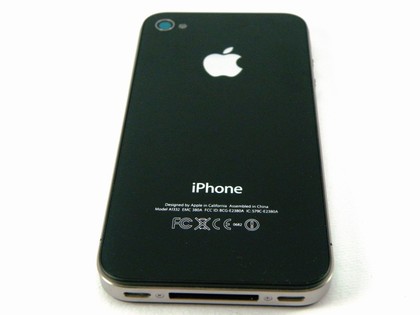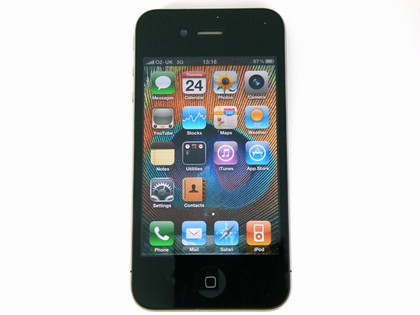TechRadar Verdict
A really great handset that only stumbles when it comes to reception - still likely to be one of the classic phones of the year
Pros
- +
Great screen
- +
Top notch 5MP camera
- +
Much-improved design
- +
Gyroscope gaming
- +
Improved call quality
- +
Overhauled iOS 4
Cons
- -
Reception issue in left hand
- -
High price
- -
No home screen widgets
- -
No social networking integration
Why you can trust TechRadar
Update: read our full iPhone 4s review.
Apple's launch of the iPhone 4 has seen the greatest excitement for a new phone ever - and with HD video recording, a super high-res screen and ridiculously slim dimensions, it's not hard to see why.
But things are a little different now - not only was the iPhone 3GS something of a non-update to the iPhone range, but there are finally decent alternatives in the smartphone market, with the HTC Desire and Samsung Galaxy S leading the Android fight right to Apple's door.
You can check out our iPhone 4 video review:
Add to that the first major leak of an Apple product a couple of months before launch, and suddenly the iPhone 4 has a lot to do to impress.

At least Apple has unleashed the big guns for this effort - before we get into the headline specs, the design itself is a massive talking point on its own.
Jobs' chats on stage to unveil a new iPhone might have got a little repetitive (best this, magical that etc) but this is the first time since the first iPhone way back in January 2007 that we've seen a variation on the standard iPhone design.

Gone is the traditional curved back and plastic exterior with slightly chunky dimensions; in is a chassis that's only 9.3mm thin at its thickest point and a new stainless steel and glass industrial design.

If you're an iPhone fan, there's a good chance you won't like the look of the iPhone the first time you pick it up - it's the same weight as the iPhone 3GS at 137g, but it's a lot smaller, with dimensions of 115.2mm x58.6 mm x 9.3mm, so it feels like a much weightier and compact model.
The edges are stainless steel, apparently forged by winged unicorns in an iceberg (or something) to be 10 times stronger than 'normal' steel.

The front and back of the phone are made of glass, which has also been treated to be a lot stronger than the normal variety we're used to seeing through and drinking out of.
This claim holds up - not only did we feel the need to drop the phone onto the floor a few times to test, someone nameless of the TechRadar team also knocked it out (an admittedly low level) window onto concrete - and not a scratch.
If you're the protective type, then you can buy an official 'Bumper' for the iPhone 4, which encases it in a small ring of rubber, if you haven't bought the handset only for its slim lines.

The chassis shape isn't the only different thing with the iPhone 4 - the whole ethos has been tweaked. For instance, no longer is there a slightly plasticky rocker switch to control volume on the left-hand side, as it's now two discrete metal buttons with '+' and '-' written on.
The volume silencer rocker switch is above too, but that has also undergone the uber-metallic treatment.

The top of the phone still holds the headphone jack, and the power/lock key. However, the 3.5mm port is now flush to the chassis, and the power button feels much nicer to hit than before.
There's also a separate microphone for noise cancelling next to this as well - we imagine a few people will be pushing paperclips in there before they realise that it's not for the SIM card slot.

The right-hand side of the chassis is still blank - no camera button sadly, which would have been nice given the extra effort Apple has clearly put into overhauling the photography system.
Still, sleek is clearly still 'in' at the Cupertino HQ, and we can't say we blame the designers when you look at the lines.
Actually, that's not true - the micro-SIM slot is hidden away here, rather than on the top. It's the same pokey key thing/slot system as before, but this time the SIM card is much smaller - Apple says to make more room for stuff inside, we say it's just to shake things up a little bit. Either way, we bet micro-SIMs become the norm before very long in all phones.

The bottom of the phone has the familiar Apple connector for charging and connecting and docking etc, and is flanked by another more microphone-y looking microphone slot and the speaker.
The front still has that one iconic button, which is much nicer to press in the new chassis, it has to be said.

Overall, the design might not impress some people the first time they pick up the phone - a number of people we showed the phone to grimaced a little bit the first time they handled it.
It's a sharp and weighty-feeling phone, make no mistake - and it doesn't sit as comfortably in the hand as well as other iPhones of the past have.
But it feels premium, and at up to £600, it had better - that's a lot to pay when you consider you could get a 42-inch 1080p LCD for £200 less these days.
In the box
At least Apple has remained consistent when it comes to the packaging - apart from a new graphic on the front to make the new iPhone 4 look more mysterious, there's not a lot different to the older iPhones.
So that means: a simple Apple USB cable, a three-pin plug adaptor and some headphones. The latter is the same old set from the year before: hands free and a function button on the cord, but slightly poor quality compared to a range of other buds on the market.

Oh, you also get that little tool for removing the micro-SIM card as well - but Apple should just save itself some money and stick a paperclip in there, as 99.99% of people will lose that little thing, panic, then improvise anyway. Well, we have. Twice.
Current page: Apple iPhone 4: Overview, design and feel
Next Page Apple iPhone 4: Retina Display
Gareth has been part of the consumer technology world in a career spanning three decades. He started life as a staff writer on the fledgling TechRadar, and has grew with the site (primarily as phones, tablets and wearables editor) until becoming Global Editor in Chief in 2018. Gareth has written over 4,000 articles for TechRadar, has contributed expert insight to a number of other publications, chaired panels on zeitgeist technologies, presented at the Gadget Show Live as well as representing the brand on TV and radio for multiple channels including Sky, BBC, ITV and Al-Jazeera. Passionate about fitness, he can bore anyone rigid about stress management, sleep tracking, heart rate variance as well as bemoaning something about the latest iPhone, Galaxy or OLED TV.
